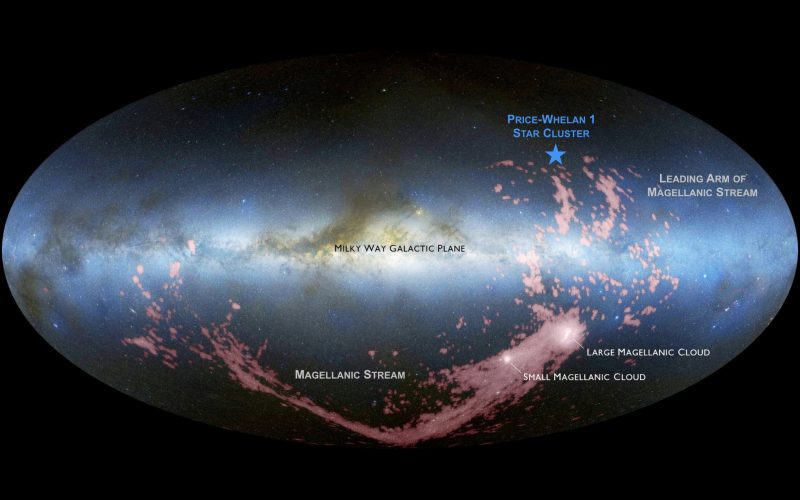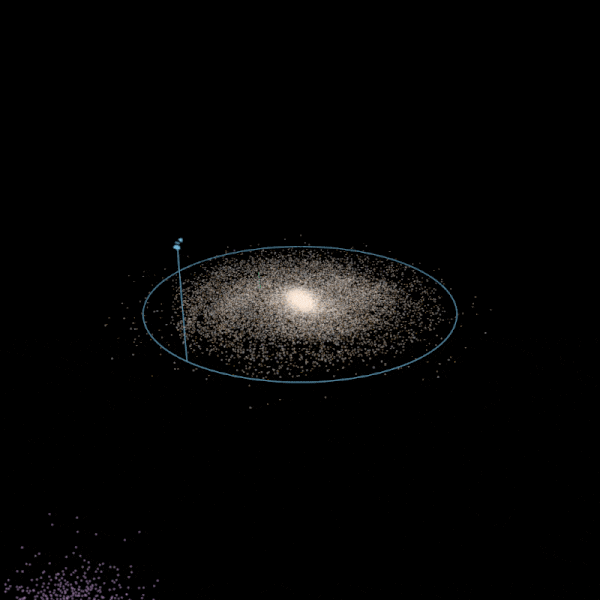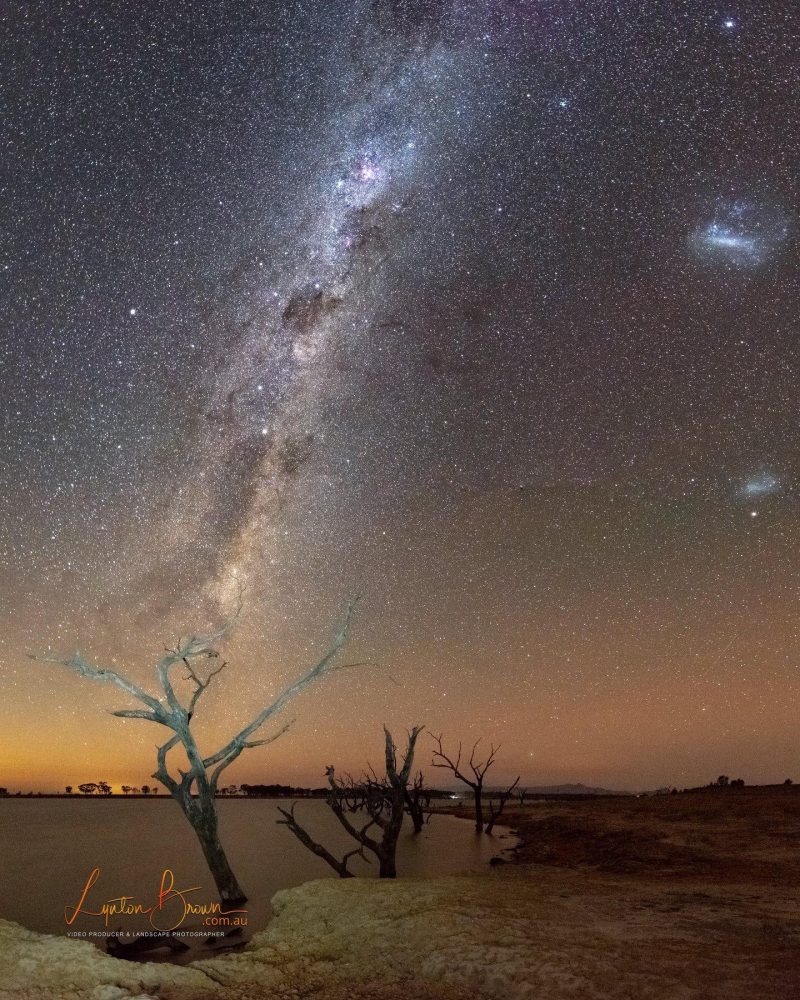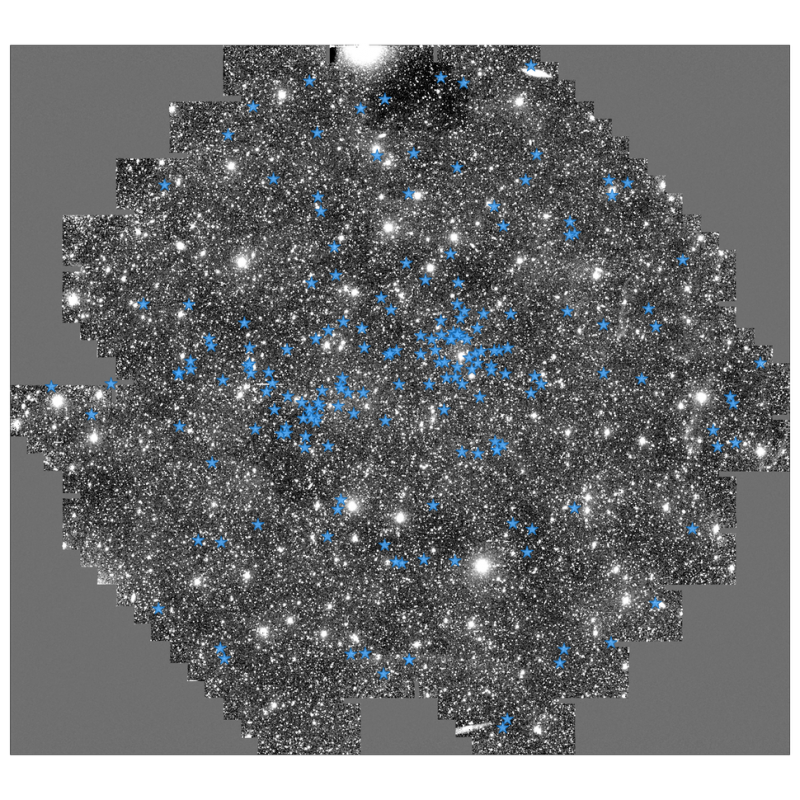

View larger. | A newly found cluster of young stars (blue stars) sits on the periphery of our Milky Way. The stars in this cluster probably formed from material originating in neighboring dwarf galaxies, called the Magellanic Clouds. Note also the Magellanic Stream, extending almost halfway around the Milky Way. Image via D. Nidever/ NASA/ Simons Foundation.
Since the 1960s and ’70s, radio astronomers have been watching a long trail of gas extending from the Magellanic Clouds, the two famous dwarf galaxies visible in Southern Hemisphere skies. This gas trail is called the Magellanic Stream, and it extends across more than 180 degrees of our sky, almost halfway around the Milky Way. The gas in the Stream, and the Magellanic Clouds themselves, will someday collide with our Milky Way, astronomers say. Now – according to a January 8, 2020, presentation by astronomers at the AAS meeting in Honolulu – it appears that signs of this collision are already in evidence. Collisions and mergers between galaxies create new stars. And astronomers have now found a young star cluster on the outskirts of our Milky Way galaxy, near the Magellanic Stream, in a part of space inhabited by our galaxy’s oldest stars. The astronomers said the stars in this young cluster appear to be made of material from the Magellanic Clouds. According to these astronomers:
The discovery suggests that [the Magellanic Stream] is about half as far from crashing into the Milky Way as previously thought.
In other words, it suggests our Milky Way’s impending collision with the Magellanic Clouds is already beginning: it’s already birthing new stars.
Adrian Price-Whelan at the Flatiron Institute’s Center for Computational Astrophysics in New York City led this research. He said the cluster now bears his name: Price-Whelan 1. Price-Whelan and his colleagues presented their findings on January 8 at the American Astronomical Society meeting in Honolulu. The work is published in two parts in the peer-reviewed Astronomical Journal: here and here.
EarthSky 2020 lunar calendars are available! Nearly sold out. Order now!

A visualization of the position of the newly discovered Price-Whelan 1 star cluster (blue points) relative to our Milky Way galaxy (white points). The star cluster probably formed from material from the Large and Small Magellanic Clouds (purple points). Image via A. Price-Whelan/ J. Hunt/ Simons Foundation.
These astronomers said in their statement:
Identifying clusters of stars is tricky because our galaxy is chock-full of the radiant orbs. Some stars may appear to be close together in the sky but actually sit at drastically different distances from Earth. Other stars may temporarily neighbor one another but move on in opposite directions.
Determining which stars are actually clustered together requires many precise measurements over time.
In this case, those measurements originated with the amazing Gaia spacecraft, which has already cataloged distances and motions for 1.7 billion Milky Way stars. Price-Whelan searched the Gaia dataset for:
… very blue stars, which are rare in the universe, and identified clumps of stars moving alongside them. After cross-matching with and removing known clusters, one remained.
The newfound cluster is relatively young at 117 million years old [very young in astronomical terms] and is on the far outskirts of the Milky Way.
He commented:
It’s really, really far away. It’s further than any known young stars in the Milky Way, which are typically in the disk. So right away, I was like, ‘Holy smokes, what is this?’

EarthSky community member
Lynton Brown captured this beautiful image of the Milky Way over Taylor’s Lake near Horsham, Australia, on April 22, 2019. The 2 objects on the right are the Magellanic Clouds. Thank you, Lynton!The Price-Whelan 1 star cluster’s location near the Magellanic Stream is a clue to these stars’ origin. These astronomers said:
Gas in the Stream doesn’t contain much metal, unlike gases in the outer reaches of the Milky Way. David Nidever, assistant professor of physics at Montana State University in Bozeman, led an analysis of the metal content of the 27 brightest stars in the cluster.
Just like the Magellanic Stream, the stars contain meager levels of metal.
The researchers propose that the cluster formed as gas from the Magellanic Stream passed through the gases surrounding the Milky Way. This pass-through created a drag force that compressed the Magellanic Stream gas. This drag, along with tidal forces from the Milky Way’s gravitational tug, condensed the gas enough to trigger star formation. Over time, the stars zoomed ahead of the surrounding gas and joined the Milky Way.
The stars’ presence presents a unique opportunity, these astronomers said. They explained:
Gauging the distance of gas from Earth is tricky and imprecise, so astronomers weren’t sure how far the Magellanic Stream was from reaching the Milky Way. The distance of stars, on the other hand, is comparatively trivial. Using the current positions and movements of stars in the cluster, the researchers predict that the edge of the Magellanic Stream is 90,000 light-years away from the Milky Way. That’s roughly half the distance previously predicted.
Nidever said:
If the Magellanic Stream is closer, especially the leading arm closest to our galaxy, then it’s likely to be incorporated into the Milky Way sooner than the current model predicts. Eventually, that gas will turn into new stars in the Milky Way’s disk. Right now, our galaxy is using up gas faster than its being replenished. This extra gas coming in will help us replenish that reservoir and make sure that our galaxy continues to thrive and form new stars.
The updated distance to the Magellanic Stream will improve models of where the Magellanic Clouds have been and where they’re going, Price-Whelan said.
He said the improved numbers could even settle a debate over whether the Magellanic Clouds have crossed through the Milky Way before, adding:
Finding an answer to that question will help astronomers better understand the history and properties of our galaxy.

Astronomers have spotted a group of young stars (blue) on the outskirts of the Milky Way. The scientists propose that these stars formed from material from two dwarf galaxies known as the Magellanic Clouds. Image via A. Price-Whelan/ Simons Foundation.
Bottom line: Astronomers have discovered a young star cluster on the outskirts of our Milky Way. Its member stars appear to be made of material from the Magellanic Clouds. The work suggests that the impending collision between our Milky Way galaxy and the Clouds and the Magellanic Stream is already beginning.
Source: Discovery of a Disrupting Open Cluster Far into the Milky Way Halo
Source: Spectroscopy of the Young Stellar Association Price-Whelan 1
from EarthSky https://ift.tt/2FxcZEB


View larger. | A newly found cluster of young stars (blue stars) sits on the periphery of our Milky Way. The stars in this cluster probably formed from material originating in neighboring dwarf galaxies, called the Magellanic Clouds. Note also the Magellanic Stream, extending almost halfway around the Milky Way. Image via D. Nidever/ NASA/ Simons Foundation.
Since the 1960s and ’70s, radio astronomers have been watching a long trail of gas extending from the Magellanic Clouds, the two famous dwarf galaxies visible in Southern Hemisphere skies. This gas trail is called the Magellanic Stream, and it extends across more than 180 degrees of our sky, almost halfway around the Milky Way. The gas in the Stream, and the Magellanic Clouds themselves, will someday collide with our Milky Way, astronomers say. Now – according to a January 8, 2020, presentation by astronomers at the AAS meeting in Honolulu – it appears that signs of this collision are already in evidence. Collisions and mergers between galaxies create new stars. And astronomers have now found a young star cluster on the outskirts of our Milky Way galaxy, near the Magellanic Stream, in a part of space inhabited by our galaxy’s oldest stars. The astronomers said the stars in this young cluster appear to be made of material from the Magellanic Clouds. According to these astronomers:
The discovery suggests that [the Magellanic Stream] is about half as far from crashing into the Milky Way as previously thought.
In other words, it suggests our Milky Way’s impending collision with the Magellanic Clouds is already beginning: it’s already birthing new stars.
Adrian Price-Whelan at the Flatiron Institute’s Center for Computational Astrophysics in New York City led this research. He said the cluster now bears his name: Price-Whelan 1. Price-Whelan and his colleagues presented their findings on January 8 at the American Astronomical Society meeting in Honolulu. The work is published in two parts in the peer-reviewed Astronomical Journal: here and here.
EarthSky 2020 lunar calendars are available! Nearly sold out. Order now!

A visualization of the position of the newly discovered Price-Whelan 1 star cluster (blue points) relative to our Milky Way galaxy (white points). The star cluster probably formed from material from the Large and Small Magellanic Clouds (purple points). Image via A. Price-Whelan/ J. Hunt/ Simons Foundation.
These astronomers said in their statement:
Identifying clusters of stars is tricky because our galaxy is chock-full of the radiant orbs. Some stars may appear to be close together in the sky but actually sit at drastically different distances from Earth. Other stars may temporarily neighbor one another but move on in opposite directions.
Determining which stars are actually clustered together requires many precise measurements over time.
In this case, those measurements originated with the amazing Gaia spacecraft, which has already cataloged distances and motions for 1.7 billion Milky Way stars. Price-Whelan searched the Gaia dataset for:
… very blue stars, which are rare in the universe, and identified clumps of stars moving alongside them. After cross-matching with and removing known clusters, one remained.
The newfound cluster is relatively young at 117 million years old [very young in astronomical terms] and is on the far outskirts of the Milky Way.
He commented:
It’s really, really far away. It’s further than any known young stars in the Milky Way, which are typically in the disk. So right away, I was like, ‘Holy smokes, what is this?’

EarthSky community member
Lynton Brown captured this beautiful image of the Milky Way over Taylor’s Lake near Horsham, Australia, on April 22, 2019. The 2 objects on the right are the Magellanic Clouds. Thank you, Lynton!The Price-Whelan 1 star cluster’s location near the Magellanic Stream is a clue to these stars’ origin. These astronomers said:
Gas in the Stream doesn’t contain much metal, unlike gases in the outer reaches of the Milky Way. David Nidever, assistant professor of physics at Montana State University in Bozeman, led an analysis of the metal content of the 27 brightest stars in the cluster.
Just like the Magellanic Stream, the stars contain meager levels of metal.
The researchers propose that the cluster formed as gas from the Magellanic Stream passed through the gases surrounding the Milky Way. This pass-through created a drag force that compressed the Magellanic Stream gas. This drag, along with tidal forces from the Milky Way’s gravitational tug, condensed the gas enough to trigger star formation. Over time, the stars zoomed ahead of the surrounding gas and joined the Milky Way.
The stars’ presence presents a unique opportunity, these astronomers said. They explained:
Gauging the distance of gas from Earth is tricky and imprecise, so astronomers weren’t sure how far the Magellanic Stream was from reaching the Milky Way. The distance of stars, on the other hand, is comparatively trivial. Using the current positions and movements of stars in the cluster, the researchers predict that the edge of the Magellanic Stream is 90,000 light-years away from the Milky Way. That’s roughly half the distance previously predicted.
Nidever said:
If the Magellanic Stream is closer, especially the leading arm closest to our galaxy, then it’s likely to be incorporated into the Milky Way sooner than the current model predicts. Eventually, that gas will turn into new stars in the Milky Way’s disk. Right now, our galaxy is using up gas faster than its being replenished. This extra gas coming in will help us replenish that reservoir and make sure that our galaxy continues to thrive and form new stars.
The updated distance to the Magellanic Stream will improve models of where the Magellanic Clouds have been and where they’re going, Price-Whelan said.
He said the improved numbers could even settle a debate over whether the Magellanic Clouds have crossed through the Milky Way before, adding:
Finding an answer to that question will help astronomers better understand the history and properties of our galaxy.

Astronomers have spotted a group of young stars (blue) on the outskirts of the Milky Way. The scientists propose that these stars formed from material from two dwarf galaxies known as the Magellanic Clouds. Image via A. Price-Whelan/ Simons Foundation.
Bottom line: Astronomers have discovered a young star cluster on the outskirts of our Milky Way. Its member stars appear to be made of material from the Magellanic Clouds. The work suggests that the impending collision between our Milky Way galaxy and the Clouds and the Magellanic Stream is already beginning.
Source: Discovery of a Disrupting Open Cluster Far into the Milky Way Halo
Source: Spectroscopy of the Young Stellar Association Price-Whelan 1
from EarthSky https://ift.tt/2FxcZEB

Aucun commentaire:
Enregistrer un commentaire